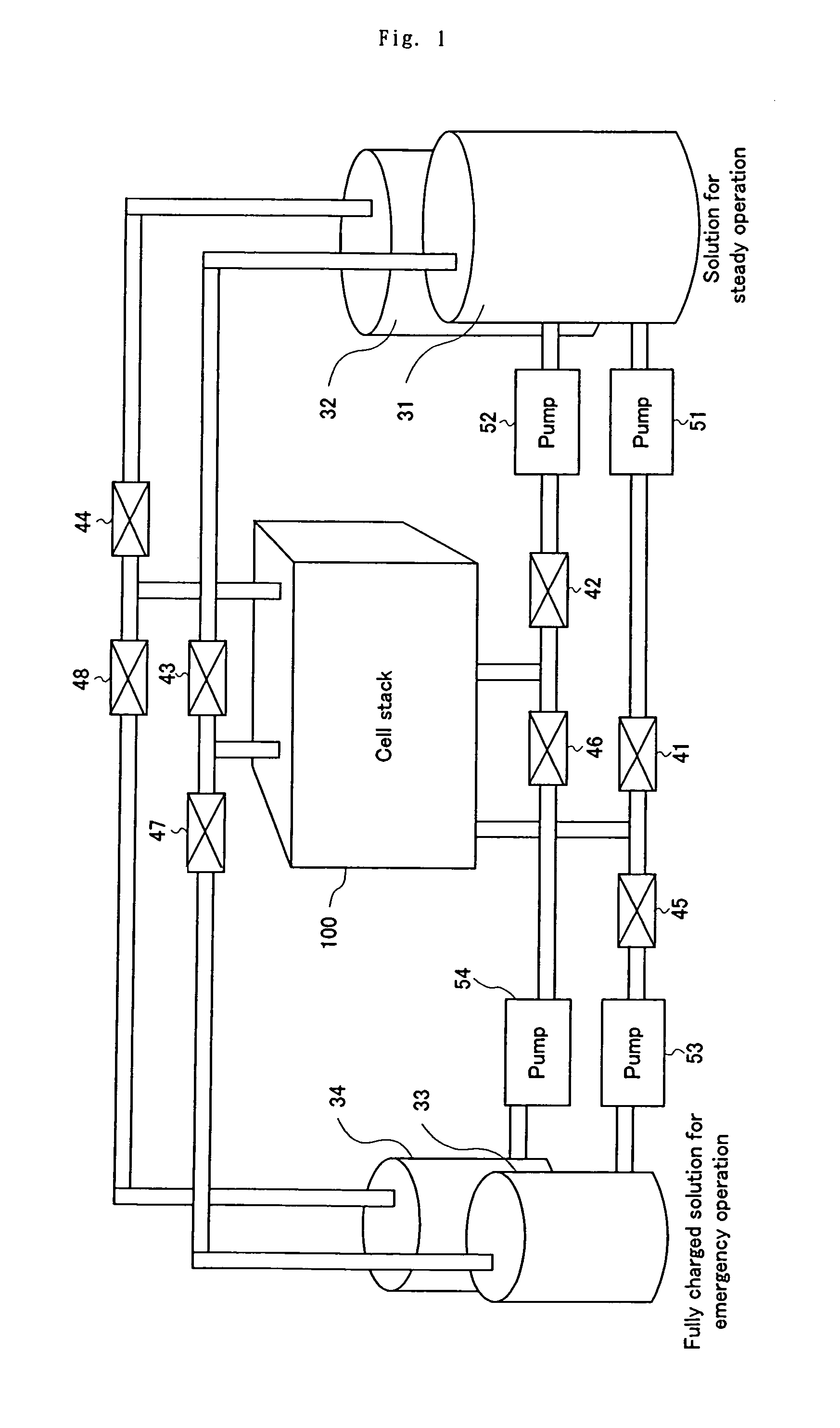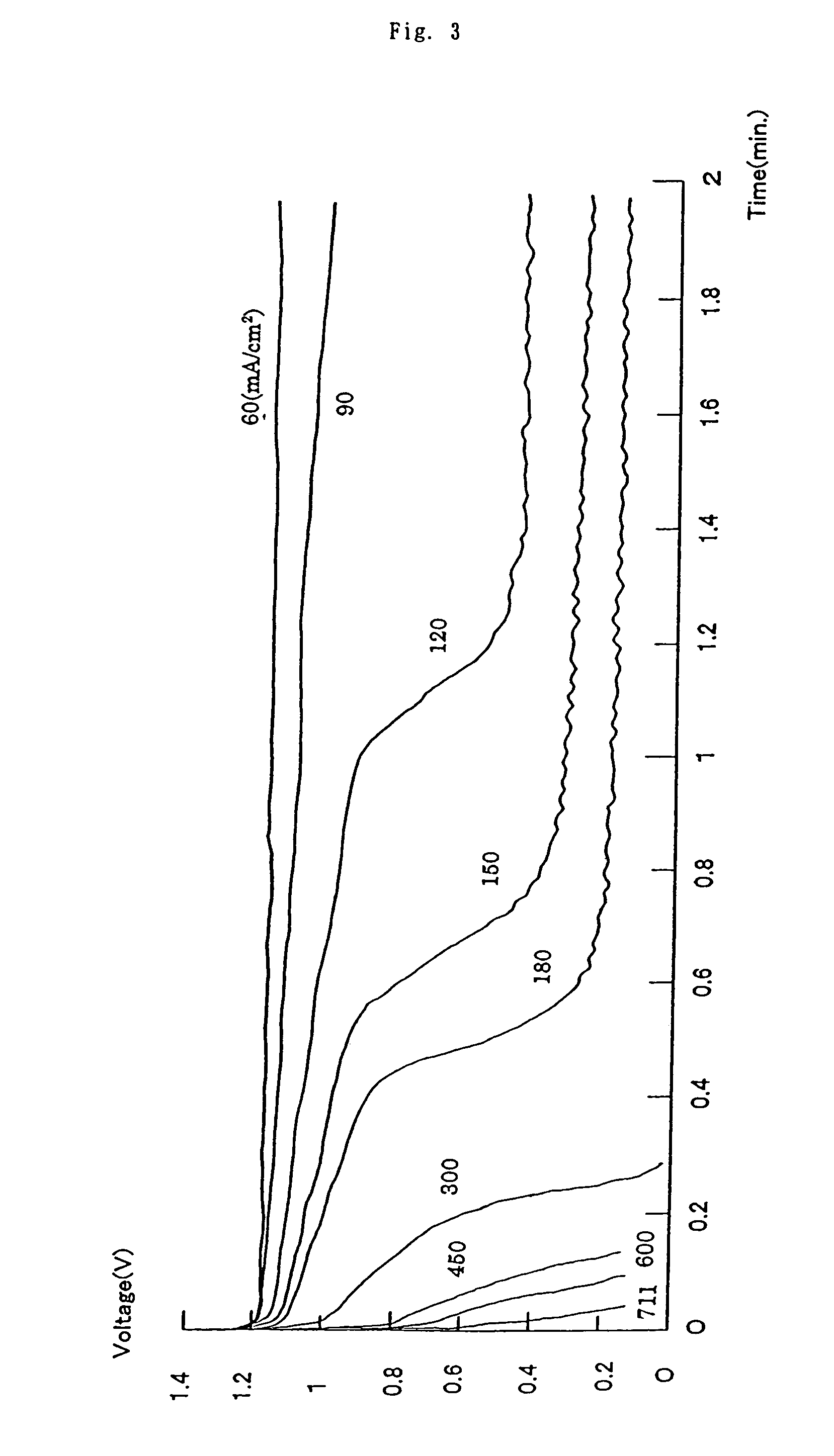Method of operating a secondary battery system having first and second tanks for reserving electrolytes
- Summary
- Abstract
- Description
- Claims
- Application Information
AI Technical Summary
Benefits of technology
Problems solved by technology
Method used
Image
Examples
first embodiment
[0031](First Embodiment)
[0032]FIG. 1 is a diagrammatic illustration of construction of a redox flow battery system of the present invention.
[0033]This battery system comprises a single cell stack 100, two sets of tanks 31, 32 and 33, 34 for reserving electrolytes, valves 41–48 for allowing switching of the electrolytes contained in the tanks 31–34, to selectively supply the electrolytes to the cell stack 100, and pumps 51–54 for circulating the electrolytes.
[0034]The cell stack 100 is identical in construction to the conventional one, as illustrated in FIGS. 6 and 7.
[0035]The tanks 31–34 comprise the first tanks 31, 32 for supplying the electrolytes to the cell stack for the purpose of load-leveling during the steady operation and the second tanks 33, 34 for supplying the electrolytes to the cell stack in an emergency operation, such as during the time of electric power failure. The first tanks and the second tanks comprise positive electrolyte tanks 31, 33 and negative electrolyte ...
second embodiment
[0044](Second Embodiment)
[0045]While in the first embodiment, the pumps 51, 52 and the pumps 53, 54 are placed for the electrolytes of the first tanks 31, 32 and the second tanks 33, 34, respectively, the pumps for each set of tanks may be combined for common use. FIG. 4 is a diagrammatic illustration of a part of a shared-pump type of redox flow battery system of the present invention. In this illustration, like reference characters refer to corresponding parts of FIG. 1.
[0046]As illustrated, pumps 55, 56 are interposed between an intermediate part of piping between the valves 41, 45 and the cell stack 100 and between an intermediate part of piping between the valves 42, 46 and the cell stack 100, respectively, for connection between the valves and the cell stack. This can allow selective switching between the electrolytes in the first tanks and the electrolytes in the second tanks and circulation of the selected electrolytes by using a total of two pumps 55, 56.
[0047]The switching...
third embodiment
[0048](Third Embodiment)
[0049]Further, a diagrammatic illustration of a part of a redox flow battery system having a plurality of cell stacks 100–102 is shown in FIG. 5. In this third embodiment as well, the selective switching between the electrolytes in the first tanks and the electrolytes in the second tanks is controlled by the valves 41–48 being opened and closed in the same manner as in the first embodiment. Thus, the high overload operation can be provided, regardless of the state of charge of the electrolytes in the first tanks.
Capabilities of Exploitation in Industry
[0050]As described above, according to the battery of the present invention, there are provided specific tanks for storing the electrolytes that are constantly kept in the substantially fully charged state, in addition to the tanks for electrolytes for used in the steady load-leveling operation. This can provide the result that in case of emergency, the required electrolytes can be fed from those specific tanks ...
PUM
 Login to View More
Login to View More Abstract
Description
Claims
Application Information
 Login to View More
Login to View More - R&D
- Intellectual Property
- Life Sciences
- Materials
- Tech Scout
- Unparalleled Data Quality
- Higher Quality Content
- 60% Fewer Hallucinations
Browse by: Latest US Patents, China's latest patents, Technical Efficacy Thesaurus, Application Domain, Technology Topic, Popular Technical Reports.
© 2025 PatSnap. All rights reserved.Legal|Privacy policy|Modern Slavery Act Transparency Statement|Sitemap|About US| Contact US: help@patsnap.com



